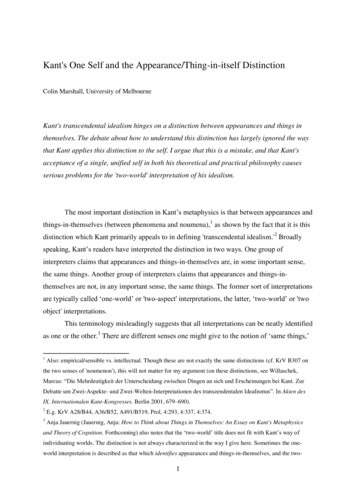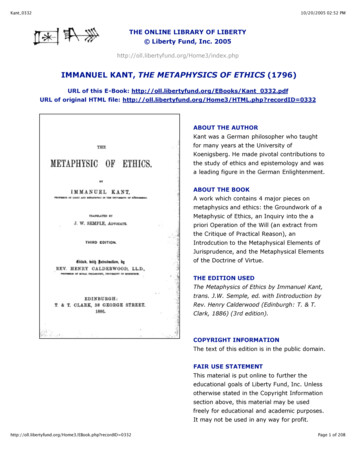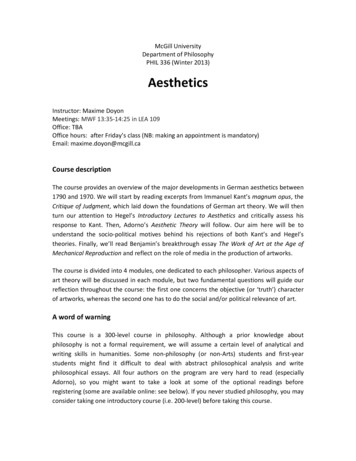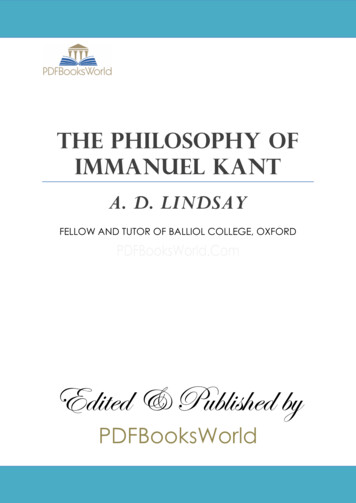
Transcription
Kant's One Self and the Appearance/Thing-in-itself DistinctionColin Marshall, University of MelbourneKant's transcendental idealism hinges on a distinction between appearances and things inthemselves. The debate about how to understand this distinction has largely ignored the waythat Kant applies this distinction to the self. I argue that this is a mistake, and that Kant'sacceptance of a single, unified self in both his theoretical and practical philosophy causesserious problems for the 'two-world' interpretation of his idealism.The most important distinction in Kant’s metaphysics is that between appearances andthings-in-themselves (between phenomena and noumena),1 as shown by the fact that it is thisdistinction which Kant primarily appeals to in defining 'transcendental idealism.'2 Broadlyspeaking, Kant’s readers have interpreted the distinction in two ways. One group ofinterpreters claims that appearances and things-in-themselves are, in some important sense,the same things. Another group of interpreters claims that appearances and things-inthemselves are not, in any important sense, the same things. The former sort of interpretationsare typically called ‘one-world’ or 'two-aspect' interpretations, the latter, ‘two-world’ or 'twoobject' interpretations.This terminology misleadingly suggests that all interpretations can be neatly identifiedas one or the other.3 There are different senses one might give to the notion of ‘same things,’1Also: empirical/sensible vs. intellectual. Though these are not exactly the same distinctions (cf. KrV B307 onthe two senses of 'noumenon'), this will not matter for my argument (on these distinctions, see Willaschek,Marcus: “Die Mehrdeutigkeit der Unterscheidung zwischen Dingen an sich und Erscheinungen bei Kant. ZurDebatte um Zwei-Aspekte- und Zwei-Welten-Interpretationen des transzendentalen Idealismus”. In Akten desIX. Internationalen Kant-Kongresses. Berlin 2001, 679–690).2E.g. KrV A28/B44, A36/B52, A491/B519, Prol, 4:293, 4:337, 4:374.3Anja Jauernig (Jauernig, Anja: How to Think about Things in Themselves: An Essay on Kant's Metaphysicsand Theory of Cognition. Forthcoming) also notes that the ‘two-world’ title does not fit with Kant’s way ofindividuating worlds. The distinction is not always characterized in the way I give here. Sometimes the oneworld interpretation is described as that which identifies appearances and things-in-themselves, and the two-1
however, so there is really a spectrum of interpretive views here. A one-world interpretermight ascribe to Kant the view that (a) each appearance is identical to some thing-in-itself,the view that (b) each appearance is some X-as-it-appears, where there is a thing-in-itself thatis the X-as-it-is-in-itself for the same X, or the view that (c) talk of an appearance is nonmetaphysical talk of an X regarded in a certain way, where one can also talk about that sameX as a thing-in-itself. 4Two-world interpreters deny that Kant accepts any of these claims, and then givesome story about what appearances and things-in-themselves are, and how they relate. Thisstory can also take a number of forms, but typically takes all the facts about appearances to bebased at some level in facts about our representations (while allowing that the facts about ourrepresentations may themselves be based at some level in facts about things-in-themselves).In what follows, I defend the following argument for the one-world interpretation,which I call the One-Self/One-World Argument:1. The self as it appears and the self as it is in itself are the same thing.2. The distinction between the self as it appears and the self as it is in itself is aninstance of the general appearance/thing-in-itself distinction.3. The general appearance/thing-in-itself distinction is metaphysically uniformwith respect to sameness.world interpretation as the denial of this. This characterization is either misleading or too narrow (see followingfn.). Sometimes the one-world interpretation is characterized as that which holds that appearances are mindindependent, but this is again too narrow (and, I argue elsewhere, too crude: Colin Marshall, “Qua-objects andKant’s appearance/thing-in-itself distinction”). Lastly, sometimes the two-world interpretation is characterizedas that which takes appearances to be constructions out of representations, and the one-world as the denial ofthis. This, though, leaves the one-world reading too underspecified (one could deny that appearances areconstructions without accepting that they are the same things as things-in-themselves). Cf. Ralph Walker: “Kanton the Number of Worlds”. In British Journal for the History of Philosophy 18. 2010, 821-843, 826ff.; DennisSchulting: “Kant's Idealism: The Current Debate”. In Kant's Idealism: New Interpretations of a ControversialDoctrine. Dordrecht 2011.4I do not claim that this is an exhaustive taxonomy. (a), (b) and (c) are sometimes treated as equivalent byKant’s commentators, but they are logically distinct. There is related interpretive possibility here that is noteasily classified: identifying appearances and things-in-themselves with different aspects of the same things (e.g.dividing up a thing's properties into two sets, and identifying one set with an appearance and another with athing in itself) while denying that appearances and things-in-themselves are the same things in any importantsense (e.g. Langton, Rae: Kantian Humility. Oxford 1998, 20). Classification issues aside, such a view wouldalso be subject to the argument that follows.2
4. Therefore, appearances and things-in-themselves are the same things.The first two premises are self-explanatory. According to the third premise, either allinstances of the distinction between an appearance and the relevant thing-in-itself (or thingsin-themselves) concern the same thing, or else none do. Given this and the first two premises,it follows that all appearances are the same things as the relevant things-in-themselves.Below, I defend the One-Self/One-World Argument by clarifying and supporting eachpremise and then considering two possible replies a two-world interpreter might make.Though the unity of the self has informed the development of some one-worldreadings,5 the question of how well a two-world reading can make sense of the unified self islargely overlooked in the literature. It does not appear, for instance, in Lucy Allais’ carefulsurvey of objections to the two-world reading.6 Robert Adams and Ralph C. S. Walker notethat Kant identifies the phenomenal and noumenal selves in his moral philosophy, but neitherthinks this has any general consequences for the one- vs. two-world debate.7 Anja Jauernig,in her forthcoming book, points out that this is a consideration that a one-world interpreter“might try to spin in his favor”, but thinks that a quick response suffices to dismiss it.8 Ibelieve, however, that the One-Self/One-World Argument deals a significant blow to the twoworld reading. The argument also implies that understanding Kant's metaphysics of the self5For instance, Prauss, Gerold: Kant und das Problem der Dinge an sich. Bonn, 1974; Allison, Henry: Kant’sTheory of Freedom. Cambridge, 1990 (especially Chapter 2); Ameriks, Karl: Kant’s Theory of Mind. Oxford,2000 (especially Chapters 6 and 7). In a related vein, Desmond Hogan has recently argued that Kant’s views onfreedom need to be given a central place in understanding even his basic epistemological claims about things inthemselves (Hogan, Desmond: “Noumenal affection.” In Philosophical Review 118, 2009, 501-532.).6Lucy Allais: “Kant’s One World: Interpreting ‘Transcendental Idealism’”. In British Journal for the History ofPhilosophy, 12. 2004. 655–684, 660-665.7“the moral argument only allows such a [phenomenal-noumenal] identification where rational beings areconcerned. clearly there can be no prospect of extending the moral argument to cover ordinary physical things”(Walker, “Kant on the number of worlds”, 837). See also Robert Adams: "Things In Themselves”. InPhilosophy and Phenomenological Research 57, 1997, 801-825, 821ff.; Karl Ameriks: Interpreting Kant'sCritiques. Oxford 2003, 84; and Wagner, Hans: “Kants affirmative Metaphysik von Dingen an sich”. In ZuKants Kritischer Philosophie. Würzberg 2008, 76-77. Interpreters who are aware of the potential force of thiscriticism of two-world readings include Allen Wood, Tobias Rosefeldt, and Henry Allison (Wood, Allen: Kant.Oxford. 2005, 74; Rosefeldt, Tobias: “Dinge an sich und sekundäre Qualitäten”. In Kant in der Gegenwart, ed.By J. Stolzenburg. Berlin and New York 2007, 167–209, 170, Allison, Henry: Essays on Kant. Oxford 2012,80). None of these interpreters fully develop the criticism, however.8Jauernig, How to Think about Things in Themselves.3
is more directly relevant to interpreting his transcendental idealism than many of his readershave assumed.One caveat: my argument rests on a fairly weak assumption of charity. I do notassume that Kant is perfectly consistent. All my argument assumes is that there is broadconsistency between those core pieces of Kant’s philosophy whose interrelations he explicitlyand repeatedly discusses. Kant may well have changed his mind about many aspects of hisidealism, but the premises of the One-Self/One-World Argument rest on tenets of hisphilosophy that we find throughout his mature works.1. The self as it appears and the self as it is in itself are the same thingKant ascribes both phenomenal and noumenal aspects to us. In the relevant passages,he uses several notions for ‘us’: the I, the self, the subject, the mind, the person and thehuman. Though there are important differences between these, I use 'self' as a blanket term inwhat follows.9How many selves are there, then? The common-sense view is that each of us hasexactly one self. All of Kant's major philosophical predecessors accepted this, though theymade sense of it in different ways. If Kant had rejected this ‘single self' view, we wouldexpect him to do so explicitly. Yet in the overwhelming majority of places where Kantdiscusses the self, he talks about a single thing.10 Only on rare occasions does he use qualifiedterminology (e.g. explicitly restricting a claim to the self as it appears or as it is in itself), andhis talk of distinct selves is rarer still. Despite this, many of Kant’s commentators imply thathe consistently distinguishes the phenomenal/empirical self from the noumenal/intelligibleself. James Van Cleve, for instance, states:9Kant’s notion of the self involves more detail than I can properly discuss here. I discuss the relevantdistinctions in Colin Marshall: “Kant’s metaphysics of the self”. In Philosophers’ Imprint 10, 2010, 1-21, 2.Perhaps the most obvious distinction concerns whether just the appearances of inner sense are included (as istrue of the mind), or also those of outer sense (as is true of the embodied human being). On the (at leastpossible) unity of the thinking self with the body Kant says: “I can [.]. assume that [.] the very same thing thatis called a body in one relation would at the same time be a thinking being in another” (“kann ich [.] annehmen[.] [daß] was in einer Beziehung körperlich heißt, in einer andern zugleich ein denkend Wesen sein”) (KrV,A359).10This is also true of his pre-critical work. See Klemme, Heiner: Kants Philosophie des Subjects. Hamburg.1995, 38-138 and Wuerth, Julian: “Kant's Immediatism, Pre-Critique”. In Journal of the History of Philosophy44, 2006, 489-532.4
Kant speaks of three different selves: the empirical self, the transcendental self, and thenoumenal self. The empirical self is the self as encountered in introspection. Thetranscendental self is the subject of all the states just mentioned: it is the thinker of ourthoughts, the haver of our experiences, the willer of our actions, and perhaps also theagent of the various activities of synthesis Kant talks about. the noumenal self is the‘self in itself’ – the real self or the self as it really is.11This is misleading. Kant almost never talks of distinct selves.12 In fact, the phrases 'empiricalself,' 'transcendental self,' and 'noumenal self' appear nowhere in any of the Critiques. Onecould respond that Kant only makes the relevant distinctions (perhaps in other terms) whenhe is being ‘serious,’ and that his usual talk of a single self is merely for presentationalpurposes. But the text does not support this response. For instance, in the dense discussion ofinner sense and apperception in §25 of the B Deduction, Kant writes that “[i]n thetranscendental synthesis of the manifold of representations in general. I am conscious ofmyself not as I appear to myself, nor as I am in myself, but only that I am” (B157).13 This issurely a serious discussion of the self, and yet Kant writes of a single self that is intuited,thought, appears, and is in itself. To be sure, whether we should take Kant at his word hinges11James Van Cleve: Problems from Kant. Oxford. 1999, 182. Van Cleve goes on to argue (quite plausibly) thatthe noumenal and transcendental selves are the same (Van Cleve, ibid. 182-85), but maintains a radicaldistinction between these and the empirical self. See also Schulting, “Kant’s Idealism”, 168-170. Thisassumption is reflected in what is described as the issue of ‘Kant’s third self.’ See Kitcher, Patricia: “Kant’sReal Self”. In Self and Nature in Kant’s Philosophy. Ithaca. 1984, 113-147, 113 and Zöller, Gunter: “MainDevelopments in Recent Scholarship on the Critique of Pure Reason”. In Philosophy and PhenomenologicalResearch 53. 1993, 445-66.12At GMS 4:457, Kant writes of the human having his 'proper self' in the intelligible world, but the contextmakes it clear that the human being is one thing, also having a phenomenal side. KprV 5:161 talks of the'invisible self,' but this is an invisible self that is said to belong to someone who also has an animal nature. Kantdoes (as we will see below) talk of us having distinct phenomenal and noumenal characters, but he consistentlyascribes those characters to a single entity (the self). In FM/Lose Blätter 20:338, Kant does talk of the“empirical I” (“das empirische Ich”) vs. the “rational I” (“das rationale Ich”) and of the “logical I” (“daslogische Ich”) vs. the “physical self” (“das physische selbst”), but simultaneously appeals to the identity of theself.13KrV, B157: “Dagegen bin ich mir meiner selbst in der transcendentalen Synthesis des Mannigfaltigen derVorstellungen überhaupt [.] bewußt, nicht wie ich mir erscheine, noch wie ich an mir selbst bin, sondern nurdaß ich bin”. See also KprV 5:114, 5:97 and 5:105.5
on whether we can make philosophical sense of there being a single self that has bothphenomenal and noumenal aspects, but it is plausible that this can be done.14 I say a bit moreat the end of this section about the textual constraints on how to understand the singleness ofthe self.It is possible that Van Cleve and others have been misled by Kant’s distinctionsbetween types of self-representation. Kant distinguishes empirical apperception and innersense from pure apperception, for instance (e.g. KrV A107, B132), but this no more impliesthat there is more than one type of self than the fact that there are empirical and pure conceptsof objects by itself implies that there is more than one type of object.15The textual grounds for the first premise are therefore extremely strong. We find moresystematic grounds in the central themes of Kant's practical philosophy.16 Two strands of thepractical philosophy are directly relevant: our necessitation by objective practical laws(Kant's view of duty), and our actions' having both empirical and non-empirical causes(Kant's compatibilism). I focus on the issue of practical necessitation here, returning tocompatibilism in the next section.17According to Kant, our relation to objective practical laws is halfway between therelation a (non-empirical) divine being has to them and the relation a non-rational animal has.A divine being's actions are directly determined by its representation of these laws (cf. GMS4:414). A non-rational animal has no representation of these laws, and acts merely on thebasis of empirical incentives (cf. KprV 5:61). The human will is subject to both rational and14For one approach, see my “Kant’s metaphysics of the self”.15See Klemme, Kants Philosophie des Subjekts, 214ff. At 7:142 in the Anthropology, Kant claims that “I as athinking being am one and the same subject with myself as a sensing being” (Anth, 7:142: “Ich, als denkendesWesen, bin zwar mit Mir, als Sinnenwesen, ein und dasselbe Subjekt”.) and in the next paragraph complainsabout psychologists who confuse inner sense with apperception. So Kant clearly distinguished the question ofhow many types of self-representation there are from the question of how many selves there are.16There are also systematic grounds in the theoretical works. The unity of the sensible and non-sensible sides ofthe self seems to be at the core of the Transcendental Deduction (e.g. KrV, A107, B140), and the Third Analogyhinges on the experiencing self entering into causal relations with empirical objects (KrV, A213/B260).17Walker, “Kant on the number of worlds”, 836 argues that some close tie between the phenomenal andnoumenal selves is needed for cross-temporal ascriptions of moral responsibility to human beings. I think thisargument is basically right, though a two-world interpreter who was willing to claim knowledge of noumenalidentities could respond that Kant’s view was just that a certain noumenal self accompanied the human bodywithout being the same thing as it.6
non-rational forces, however.18 Kant describes this view in grandiose terms at the end of thesecond Critique:Two things fill the mind with ever new and increasing admiration and reverence. thestarry heavens above me and the moral law within me [.] The first begins from the placeI occupy in the external world of sense [.] The second begins from my invisible self, mypersonality, and presents me in a world which has true infinity but which can bediscovered only by the understanding, and I cognize that my connection with that world(and thereby with all those visible worlds as well) is not merely contingent, as in the firstcase, but universal and necessary. The first [.] annihilates, as it were, my importance asan animal creature [.] The second, on the contrary, infinitely raises my worth as anintelligence by my personality, in which the moral law reveals to me a life independentof animality and even of the whole sensible world19As Kant describes it, then, our distinctive status hinges on our being both phenomenal andnoumenal. So, if we take him at his word, it is crucial to Kant's central philosophical concernsthat the self is a single thing with both noumenal and phenomenal sides. Matters would bedifferent if there were two selves, a noumenal and a phenomenal one. That would seem to bemore like a case of an angel pushing around an animal. In the Metaphysics of Morals, Kant isclear that the singleness of the self is crucial to understanding our duties:The subject that is bound, as well as the subject that binds, is always the human beingonly; and though we may, in a theoretical respect, distinguish soul and body from eachother, as natural characteristics of a human being, we may not think of them as different1819See, e.g., GMS, 4:413, KprV, 5:20, MS, 6:387, 6:420KprV, 5:161-62: “Zwei Dinge erfüllen das Gemüth mit immer neuer und zunehmender Bewunderung undEhrfurcht [.] der bestirnte Himmel über mir und das moralische Gesetz in mir. [.] Das erste fängt von demPlatze an, den ich in der äußern Sinnenwelt einnehme [.] Das zweite fängt von meinem unsichtbaren Selbst,meiner Persönlichkeit, an und stellt mich in einer Welt dar, die wahre Unendlichkeit hat, aber nur dem Verstandespürbar ist, und mit welcher (dadurch aber auch zugleich mit allen jenen sichtbaren Welten) ich mich nicht wiedort in blos zufälliger, sondern allgemeiner und nothwendiger Verknüpfung erkenne. Der erstere Anblick [.]vernichtet gleichsam meine Wichtigkeit, als eines thierischen Geschöpfs [.] Der zweite erhebt dagegen meinenWerth, als einer Intelligenz, unendlich durch meine Persönlichkeit, in welcher das moralische Gesetz mir ein [.]von der ganzen Sinnenwelt unabhängiges Leben offenbart”. See also KU, 5:403.7
substances putting him under obligation, so as to justify a division of duties to the bodyand duties to the soul 20It would be a serious cost to an interpretation it could not make sense of this tenet of Kant'spractical philosophy.21 As I emphasized earlier, moreover, such an interpretation would beforced to reject the natural reading of vast amounts of text. In slogan form: dividing the self isdeeply un-Kantian. 22In what follows, it will help to have a clear sense of how Kant describes the dualcharacter and singleness of the self, though I continue to remain neutral on how thatsingleness should be understood. Two of the clearest formulations appear in the resolution tothe Third Antinomy:for a subject of the world of sense we would have first an empirical character [.] onewould also have to allow this subject an intelligible character, through which it is indeedthe cause of those actions as appearances, but which does not stand under any conditionsof sensibility and is not itself appearance. The first one could call the character of such athing in appearance, the second its character as a thing in itself.2320MS, 6:418-19: “Das verpflichtete sowohl als das verpflichtende Subject ist immer nur der Mensch, und wennes uns in theoretischer Rücksicht gleich erlaubt ist im Menschen Seele und Körper als Naturbeschaffenheiten desMenschen von einander zu unterscheiden, so ist es doch nicht erlaubt sie als verschiedene den Menschenverpflichtende Substanzen zu denken, um zur Eintheilung in Pflichten gegen den Körper und gegen die Seeleberechtigt zu sein”.21For a helpful discussion, see Chapter 3 of Marcus Willaschek: Praktische Vernunft. Handlungstheorie undMoralbegründung bei Kant. Stuttgart/Weimar. 1992.22Another interpretive route is to deny that the self is a thing at all (e.g. P. F. Strawson: The Bounds of Sense.London. 1966, 166), in which case there would be no issue of unity. This interpretation is hard to motivate,though (cf. Robert Howell” “Kant, the ‘I think,’ and self-awareness”. In Kant’s Legacy, ed. by P. Cicovacki.Rochester. 2001, 117-152, 121, and my “Kant’s metaphysics of the self”, 8-9.23KrV, A539/B567: “da würden wir an einem Subjecte der Sinnenwelt erstlich einen empirischen Charakterhaben [.]Zweitens würde man ihm noch einen intelligibelen Charakter einräumen müssen, dadurch es zwar dieUrsache jener Handlungen als Erscheinungen ist, der aber selbst unter keinen Bedingungen der Sinnlichkeit stehtund selbst nicht Erscheinung ist. Man könnte auch den ersteren den Charakter eines solchen Dinges in derErscheinung, den zweiten den Charakter des Dinges an sich selbst nennen.”8
the human being [.] is in one part phenomenon, but in another part [understanding andreason] he is a merely intelligible object24These passages describe the issue in metaphysical terms. In the first passage, Kant claims thatthe subject has two characters, an intelligible one and an empirical one. This fits reasonablywell with the formulation in the second passage, where he talks of the human having parts. Irefer to these below as 'two-part' formulations of the singleness of the dual-character self.Kant also ascribes the dual character to a single faculty of the self (the will):just the same will is thought of in the appearance (in visible actions) as necessarilysubject to the law of nature and to this extent not free, while yet on the other hand it isthought of as belonging to a thing in itself as not subject to that law, and hence as free25one can consider the causality of this being in two aspects, as intelligible in its action as athing in itself, and as sensible in the effects of that action as an appearance in the worldof sense. 26I do not think much turns on whether one privileges talk of duality of the self or talk of theduality of the will; if the will can be both phenomenal and noumenal without losing its unity,then the unified self can likewise be phenomenal and noumenal. The feature of theseformulations that does merit attention is their use of representational terms: the will is'thought of as' or 'considered as' phenomenal or as noumenal. Different one-worldinterpretations take this use of representational terms more or less metaphysically. Withouttaking a stand on that question, I refer to this latter sort of formulations as 'two-aspect'formulations of the singleness of the self.24KrV, A546/B574: “der Mensch [.] ist sich selbst freilich eines Theils Phänomen, anderen Theils aber, nämlichin Ansehung gewisser Vermögen, ein bloß intelligibeler Gegenstand”.25KrV, Bxxvii-xxviiii: “so wird eben derselbe Wille in der Erscheinung (den sichtbaren Handlungen) als demNaturgesetze nothwendig gemäß und so fern nicht frei und doch andererseits als einem Dinge an sich selbstangehörig jenem nicht unterworfen, mithin als frei gedacht”.26KrV, A538/B566: “so kann man die Causalität dieses Wesens auf zwei Seiten betrachten, als intelligibel nachihrer Handlung als eines Dinges an sich selbst, und als sensibel nach den Wirkungen derselben als einerErscheinung in der Sinnenwelt.” In the Vigilantius lectures, Kant says that our power of choice is “partimsensualis, partim intellectualis” (V-MS/Vigil, 29:1016). In addition to two-aspect talk (e.g. KprV, 5:114), thesecond Critique also talks of one and the same being belonging to two worlds (see KprV, 5:105).9
Of course, one could doubt whether the above passages should be read literally. Infact, the following sections show that a two-world interpreter has reason to find some nonliteral readings. The onus, though, would be for the two-world interpreter to defend a nonliteral reading and to show that it does not face an analogue of the following problems.2. The distinction between the self as it appears and the self as it is in itself is an instanceof the general distinction between appearances and things-in-themselvesA two-world interpreter might respond at this point by insisting that theappearance/thing-in-itself distinction just has a different meaning when applied to the selfthan when applied to other entities. I suspect that many interpreters have been attracted bythis line of thought. It is important to recognize, then, that the text does not support it. Thereis both a general and a specific textual argument for the claim that Kant takes himself to beunivocally applying the appearance/thing-in-itself distinction to the self and to other entities.The general argument is this: throughout all of his mature writings, Kant uses thesame terminology in discussing the phenomenal/noumenal aspects of the self and indiscussing the phenomenal/noumenal aspects of other entities. Were it the case that he reallyhas in mind two different distinctions, we would expect him to clarify this at some point:Kant rarely shies away from making distinctions among distinctions.The specific textual argument stems from passages where Kant directly applies thegeneral distinction to the self. Such direct application suggests that he thinks there is nothingdistinctive about the meaning of the distinction in the case of the self.This direct application is conspicuous in Kant's discussions of his compatibilism.Here are three relevant passages. The first appears in the B Preface:if the critique has not erred in teaching that the object should be taken in a twofoldmeaning, namely as appearance or as thing in itself; if its deduction of the pure conceptsof the understanding is correct, and hence the principle of causality applies only to thingstaken in the first sense, namely insofar as they are objects of experience, while things inthe second meaning are not subject to it; then just the same will is thought of in theappearance (in visible actions) as necessarily subject to the law of nature and to thisextent not free, while yet on the other hand it is thought of as belonging to a thing in10
itself as not subject to that law, and hence as free, without any contradiction herebyoccurring27Kant begins with the general appearance/thing-in-itself distinction, and directly moves to thecase of the single will. Indeed, as the B Preface paints it, part of Kant's motivation forgenerally distinguishing appearances from things-in-themselves is to make room for hiscompatibilism. If that is right, then it is crucial that the application of the distinction beunivocal.We see the same pattern in the resolution to the Third Antinomy. At the beginning ofthe section, “The possibility of causality through freedom united with the universal law ofnatural necessity,” Kant writes:I call intelligible that in an object of sense which is not itself appearance. Accordingly, ifthat which must be regarded as appearance in the world of sense has in itself a facultywhich is not an object of intuition through which it can be the cause of appearances, thenone can consider the causality of this being in two aspects, as intelligible in its action as athing in itself, and as sensible in the effects of that action as an appearance in the worldof sense [.] [this] does not contradict any of the concepts we have to form of appearanceand of a possible experience. For since these appearances, because they are not things inthemselves, must be grounded in a transcendental object [.] nothing hinders us fromascribing to this transcendental object, apart from the property through which it appears,another causality that is not appearance2827KrV, Bxxvii-xxviii “Wenn aber die Kritik nicht geirrt hat, da sie das Object in zweierlei Bedeutung nehmenlehrt, nämlich als Erscheinung oder als Ding an sich selbst; wenn die Deduction ihrer Verst
dividing up a thing's properties into two sets, and identifying one set with an appearance and another with a thing in itself) while denying that appearances and things-in-themselves are the same things in any important sense (e.g. Langton, Rae: Kantian Humility. Oxford 1998, 20). Classification issues aside, such a view would











